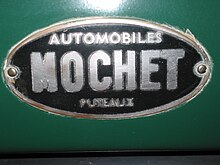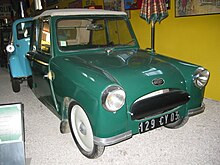Mochet




Georges Mochet began to produce cycle-cars at his, now-demolished, premises at 68, Rue Roque-de-Fillol at Puteaux in approximately 1946 and by about 1952 had progressed to more modern looking two seater micro-cars and powered two-wheelers. In 1958, with approximately 3,000 vehicles manufactured, production ended.
Georges had inherited the business from his father,
The continuation of recumbent cycle production and of the cycle-cars, popular in occupied, no-petrol France, and the subsequent switch to micro-cars under Georges after the
Under Georges Mochet the cars were powered by small single cylinder two stroke Ydral engines initially of 100 cc installed at the back and driving the rear wheels. By the time manufacturing ended, the engine size had increased to 175 cc. During this time the body work also evolved, with improved weather protection a welcome aspect of later models.[1]
There is a Mochet three-wheeler cycle car in a museum dating from 1947, described by one commentator as “very rustic”,
In October 1953, at the Paris Motor Show, Mochet exhibited a modern looking small cabriolet bodied car closer in size to a (small) normal car.[2] The car was powered by a twin cylinder 748cc unit providing a claimed 40 hp of output.[2] The unit was based on the engines used by the BMW motor bikes used by the police. However, this Mochet 750 never progressed beyond the prototype stage.[2]
See also
References
- Notes
- ^ a b c "Automobilia". Toutes les voitures françaises 1953 (Salon Paris oct 1952). Nr. 14. Paris: Histoire & collections: 45. 2000.
{{cite journal}}:|volume=has extra text (help) - ^ a b c "Automobilia". Toutes les voitures françaises 1954 (Salon Paris oct 1953). Nr. 24. Paris: Histoire & collections: 41. 2002.
{{cite journal}}:|volume=has extra text (help)
- Bibliography
- Harald H. Linz, Halwart Schrader: Die große Automobil-Enzyklopädie, BLV, München 1986, ISBN 3-405-12974-5
- G.N. Georgano: Autos. Encyclopédie complète. 1885 à nos jours. Courtille, 1975 (French)
External links
![]() Media related to Mochet at Wikimedia Commons
Media related to Mochet at Wikimedia Commons
